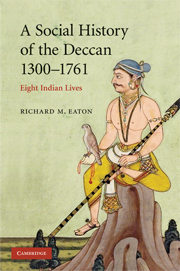Book contents
- Frontmatter
- Introduction
- 1 Pratapa Rudra (R. 1289–1323): the demise of the regional kingdom
- 2 Muhammad Gisu Daraz (1321–1422): Muslim piety and state authority
- 3 Mahmud Gawan (1411–1481): Deccanis and Westerners
- 4 Rama Raya (1484–1565): élite mobility in a Persianized world
- 5 Malik Ambar (1548–1626): the rise and fall of military slavery
- 6 Tukaram (1608–1649): non-brahmin religious movements
- 7 Papadu (fl. 1695–1710): social banditry in Mughal Telangana
- 8 Tarabai (1675–1761): the rise of Brahmins in politics
- Select bibliography
- Index
- Plate Section"
Introduction
Published online by Cambridge University Press: 28 March 2008
- Frontmatter
- Introduction
- 1 Pratapa Rudra (R. 1289–1323): the demise of the regional kingdom
- 2 Muhammad Gisu Daraz (1321–1422): Muslim piety and state authority
- 3 Mahmud Gawan (1411–1481): Deccanis and Westerners
- 4 Rama Raya (1484–1565): élite mobility in a Persianized world
- 5 Malik Ambar (1548–1626): the rise and fall of military slavery
- 6 Tukaram (1608–1649): non-brahmin religious movements
- 7 Papadu (fl. 1695–1710): social banditry in Mughal Telangana
- 8 Tarabai (1675–1761): the rise of Brahmins in politics
- Select bibliography
- Index
- Plate Section"
Summary
There is properly no history; only biography.
Ralph Waldo Emerson (1841)In early January 1996, a fierce blizzard had just blanketed Washington DC in snow. Icy winds howled outside the narrow, Gothic windows that encircled my tiny study, perched high up in one of the fairytale towers of the Smithsonian Castle. While I tried to stay warm in that dilapidated but charming relic of the nineteenth century, my mind was a world away. I was pondering “the social history of the Deccan” on a cold day, part of a year spent as a fellow with the Woodrow Wilson Center for Scholars.
I first had to resolve some knotty conceptual problems, one of which was geographic in nature. Most historians of India write about, or simply presume, coherent core regions – that is, areas characterized by stable, long-term political and cultural institutions. Like magnets, nucleated political cores attract armies, scholars, foreign visitors, long-distance merchants, and crucially, court chroniclers. Ultimately, owing to the considerable data left behind by such groups, these regions also attract modern historians. This might explain why core areas like north India, Bengal, or the Tamil south are comparatively well covered in the historical literature.
But the Deccan is a relatively understudied region, partly because it has no enduring political or cultural center. To be sure, one finds sporadic periods of imperial rule from capital cities like Kalyana under the Chalukyas, Bidar under the Bahmanis, or Vijayanagara under its first three dynasties. But in history's larger sweep, this dry and mainly undifferentiated upland plateau never possessed a single, perennial political core, no lasting hub of imperial rule on the order of Delhi or the Kaveri delta.
- Type
- Chapter
- Information
- A Social History of the Deccan, 1300–1761Eight Indian Lives, pp. 1 - 8Publisher: Cambridge University PressPrint publication year: 2005

